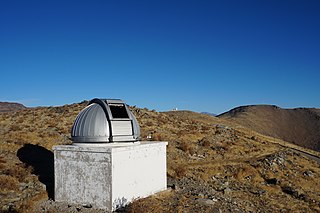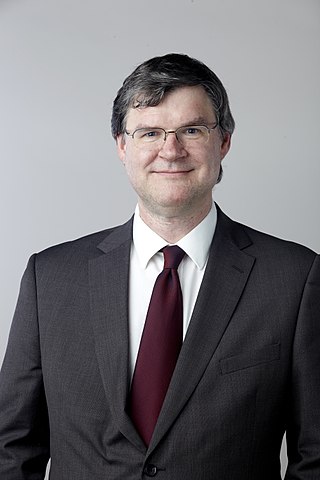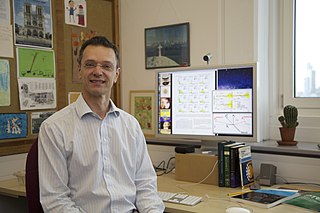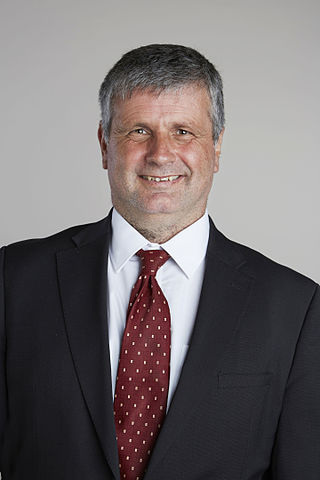Related Research Articles
Helioseismology is the study of the structure and dynamics of the Sun through its oscillations. These are principally caused by sound waves that are continuously driven and damped by convection near the Sun's surface. It is similar to geoseismology, or asteroseismology, which are respectively the studies of the Earth or stars through their oscillations. While the Sun's oscillations were first detected in the early 1960s, it was only in the mid-1970s that it was realized that the oscillations propagated throughout the Sun and could allow scientists to study the Sun's deep interior. The term was coined by Douglas Gough in the 90s. The modern field is separated into global helioseismology, which studies the Sun's resonant modes directly, and local helioseismology, which studies the propagation of the component waves near the Sun's surface.

Chthonian planets are a hypothetical class of celestial objects resulting from the stripping away of a gas giant's hydrogen and helium atmosphere and outer layers, which is called hydrodynamic escape. Such atmospheric stripping is a likely result of proximity to a star. The remaining rocky or metallic core would resemble a terrestrial planet in many respects.
Eric Ronald Priest is Emeritus Professor at St Andrews University, where he previously held the Gregory Chair of Mathematics and a Bishop Wardlaw Professorship.

The Birmingham Solar Oscillations Network (BiSON) consists of a network of six remote solar observatories monitoring low-degree solar oscillation modes. It is operated by the High Resolution Optical Spectroscopy group of the School of Physics and Astronomy at the University of Birmingham, UK, in collaboration with Sheffield Hallam University, UK. They are funded by the Science and Technology Facilities Council (STFC).

The Department of Physics and Astronomy at the University of Manchester is one of the largest and most active physics departments in the UK, taking around 330 new undergraduates and 50 postgraduates each year, and employing more than 80 members of academic staff and over 100 research fellows and associates. The department is based on two sites: the Schuster Laboratory on Brunswick Street and the Jodrell Bank Centre for Astrophysics in Cheshire, international headquarters of the Square Kilometre Array (SKA).
Dame Lynn Faith Gladden is the Shell Professor of Chemical Engineering at the University of Cambridge. She served as Pro-vice-chancellor for research from 2010 to 2016.

Michele Karen Dougherty is a British space scientist who is professor of space physics at Imperial College London. She is leading unmanned exploratory missions to Saturn and Jupiter and is Principal Investigator for J-MAG – a magnetometer for the European Space Agency's Jupiter Icy Moons Explorer, launched in April 2023.
The Phoebus group is an international team of European, Japanese and American scientists aiming at detecting the solar g modes. As of October 5, 2009, the group has finally produced a review summarising the work performed over the past 12 years.

Joanna Dorothy Haigh is a British physicist and academic. Before her retirement in 2019 she was Professor of Atmospheric Physics at Imperial College London, and co-director of the Grantham Institute – Climate Change and Environment. She served as head of the department of physics at Imperial College London. She is a Fellow of the Royal Society (FRS), and a served as president of the Royal Meteorological Society.

David George Charlton is Professor of Particle Physics in the School of Physics and Astronomy at the University of Birmingham, UK. From 2013 to 2017, he served as Spokesperson of the ATLAS experiment at the Large Hadron Collider at CERN. Prior to becoming Spokesperson, he was Deputy Spokesperson for four years, and before that Physics Coordinator of ATLAS in the run-up to the start of collision data-taking.

Terence Richard Wyatt is a Professor in the School of Physics and Astronomy at the University of Manchester, UK.

Jenny Nelson is Professor of Physics in the Blackett Laboratory and Head of the Climate change mitigation team at the Grantham Institute - Climate Change and Environment at Imperial College London.

Sir Steven Charles Cowley is a British theoretical physicist and international authority on nuclear fusion and astrophysical plasmas. He has served as director of the United States Department of Energy (DOE) Princeton Plasma Physics Laboratory (PPPL) since 1 July 2018. Previously he served as president of Corpus Christi College, Oxford, since October 2016. and head of the EURATOM / CCFE Fusion Association and chief executive officer of the United Kingdom Atomic Energy Authority (UKAEA). He was appointed chair of the board of trustees of the Faraday Institution in July 2024.

Simon John Lilly FRS is a professor in the Department of Physics at ETH Zürich.

Andrew Peter Mackenzie is a director of Physics of Quantum Materials at the Max Planck Institute for Chemical Physics of Solids in Dresden, Germany and Professor of Condensed Matter Physics at the University of St Andrews, Scotland. He became a co-editor of the Annual Review of Condensed Matter Physics as of 2020.
Raymond Ethan Goldstein FRS FInstP is the Alan Turing Professor of Complex Physical Systems in the Department of Applied Mathematics and Theoretical Physics (DAMTP) at the University of Cambridge and a Fellow of Churchill College, Cambridge.
Robin Marshall is an Emeritus professor of Physics & Biology in the School of Physics and Astronomy at the University of Manchester.
Jennifer Anne Thomas,, is a British experimental particle physicist and professor at University College London. She has been a pioneer in the development of particle detectors, and the recipient of the Michael Faraday medal and prize in 2018 for her "outstanding investigations into the physics of neutrino oscillations".
Philippa K. Browning is a Professor of Astrophysics in the Jodrell Bank Centre for Astrophysics at the University of Manchester. She specialises in the mathematical modelling of fusion and solar plasmas.
Andrew Dawson Taylor was director of the Science and Technology Facilities Council National Laboratories – Rutherford Appleton Laboratory, Daresbury Laboratory, and the UK Astronomy Technology Centre in Edinburgh until his retirement in 2019.
References
- 1 2 3 Anon (2015). "Professor Yvonne Elsworth FRS". London: Royal Society. Archived from the original on 6 March 2016. One or more of the preceding sentences incorporates text from the royalsociety.org website where:
"All text published under the heading 'Biography' on Fellow profile pages is available under Creative Commons Attribution 4.0 International License." -- "Royal Society Terms, conditions and policies". Archived from the original on 25 September 2015. Retrieved 9 March 2016.
{{cite web}}: CS1 maint: unfit URL (link) - 1 2 3 Anon (2015). "Professor Yvonne Elsworth BSc, PhD, FRAS, FInstP Professor of Helioseismology Poynting Professor of Physics". University of Birmingham. Archived from the original on 4 March 2016.
- ↑ "Archived copy". astro.phys.au.dk. Archived from the original on 11 June 2007. Retrieved 12 January 2022.
{{cite web}}: CS1 maint: archived copy as title (link) - 1 2 Elsworth, Yvonne P. (1976). A field-compensated multiplex spectrometer for the visible region (PhD thesis). University of Manchester. ProQuest 301333536.
- ↑ Elsworth, Y; James, J F; Sternberg, R S (1974). "A field compensated interference spectrometer for the visible region: the optical design". Journal of Physics E: Scientific Instruments. 7 (10): 813–816. Bibcode:1974JPhE....7..813E. doi:10.1088/0022-3735/7/10/011.
- ↑ Hopkinson, G. R.; Elsworth, Yvonne; James, J. F. (1974). "Dust in the head of Comet Kohoutek". Nature. 249 (5454): 233–234. Bibcode:1974Natur.249..233H. doi:10.1038/249233a0. S2CID 4156717.
- ↑ Hopkinson, G. R.; Elsworth, Yvonne; James, J. F. (1974). "Photometry of the zodiacal light in the near infrared". Nature. 251 (5477): 694. Bibcode:1974Natur.251Q.694H. doi: 10.1038/251694a0 . S2CID 4198740.
- ↑ Elsworth, Y; James, J F (1973). "An optical screw with a pitch of one wavelength". Journal of Physics E: Scientific Instruments. 6 (11): 1134–1136. Bibcode:1973JPhE....6.1134E. doi:10.1088/0022-3735/6/11/027.
- ↑ Yvonne Elsworth's publications indexed by the Scopus bibliographic database. (subscription required)
- ↑ Chaplin, W. J.; Kjeldsen, H.; Christensen-Dalsgaard, J.; Basu, S.; Miglio, A.; Appourchaux, T.; Bedding, T. R.; Elsworth, Y.; Garcia, R. A.; Gilliland, R. L.; Girardi, L.; Houdek, G.; Karoff, C.; Kawaler, S. D.; Metcalfe, T. S.; Molenda-Zakowicz, J.; Monteiro, M. J. P. F. G.; Thompson, M. J.; Verner, G. A.; Ballot, J.; Bonanno, A.; Brandao, I. M.; Broomhall, A.- M.; Bruntt, H.; Campante, T. L.; Corsaro, E.; Creevey, O. L.; Dogan, G.; Esch, L.; Gai, N.; Gaulme, P.; Hale, S. J.; Handberg, R.; Hekker, S.; Huber, D.; Jimenez, A.; Mathur, S.; Mazumdar, A.; Mosser, B.; New, R.; Pinsonneault, M. H.; Pricopi, D.; Quirion, P.- O.; Regulo, C.; Salabert, D.; Serenelli, A. M.; Aguirre, V. S.; Sousa, S. G.; Stello, D.; Stevens, I. R.; Suran, M. D.; Uytterhoeven, K.; White, T. R.; Borucki, W. J.; Brown, T. M.; Jenkins, J. M.; Kinemuchi, K.; Van Cleve, J.; Klaus, T. C. (2011). "Ensemble Asteroseismology of Solar-Type Stars with the NASA Kepler Mission". Science. 332 (6026): 213–216. arXiv: 1109.4723 . Bibcode:2011Sci...332..213C. doi:10.1126/science.1201827. PMID 21474754. S2CID 33911883.
- ↑ Bedding, Timothy R.; Mosser, Benoit; Huber, Daniel; Montalbán, Josefina; Beck, Paul; Christensen-Dalsgaard, Jørgen; Elsworth, Yvonne P.; García, Rafael A.; Miglio, Andrea; Stello, Dennis; White, Timothy R.; De Ridder, Joris; Hekker, Saskia; Aerts, Conny; Barban, Caroline; Belkacem, Kevin; Broomhall, Anne-Marie; Brown, Timothy M.; Buzasi, Derek L.; Carrier, Fabien; Chaplin, William J.; Di Mauro, Maria Pia; Dupret, Marc-Antoine; Frandsen, Søren; Gilliland, Ronald L.; Goupil, Marie-Jo; Jenkins, Jon M.; Kallinger, Thomas; Kawaler, Steven; Kjeldsen, Hans; Mathur, Savita; Noels, Arlette; Aguirre, Victor Silva; Ventura, Paolo (2011). "Gravity modes as a way to distinguish between hydrogen- and helium-burning red giant stars". Nature. 471 (7340): 608–611. arXiv: 1103.5805 . Bibcode:2011Natur.471..608B. doi:10.1038/nature09935. PMID 21455175. S2CID 4338871.
- ↑ Anon (2015). "UK government grants awarded to Yvonne Elsworth". Swindon: Research Councils UK. Archived from the original on 15 March 2016.
- ↑ Anon (2011). "2011 Payne-Gaposchkin Medal and Prize". iop.org. Retrieved 18 July 2014.
- ↑ "Professor Yvonne Elsworth: 2020 Gold Medal in Geophysics" (PDF). RAS. Retrieved 25 August 2020.
- ↑ Anon (2015). "Yvonne Elsworth (FRAS) elected a Fellow of the Royal Society (FRS)". ras.org.uk.